If you have ever opened up your sewing machine to poke around in all the moving parts, you know that these are complicated appliances! Whether you want the confidence to repair your sewing machine or the chance to find a job repairing sewing machines professionally, you are probably looking for the tools and training to help you become an expert.
Learning how to repair sewing machines can be as basic as reading the manual of your sewing machine to make simple adjustments or as comprehensive as gaining certification as a sewing machine repair technician. Either way, learning how to repair a sewing machine will give you valuable sewing skills.
In this article, you will learn why it is helpful to know how to repair sewing machines, how to find the right sewing machine repair training for you, and how to complete simple DIY fixes on your machine.
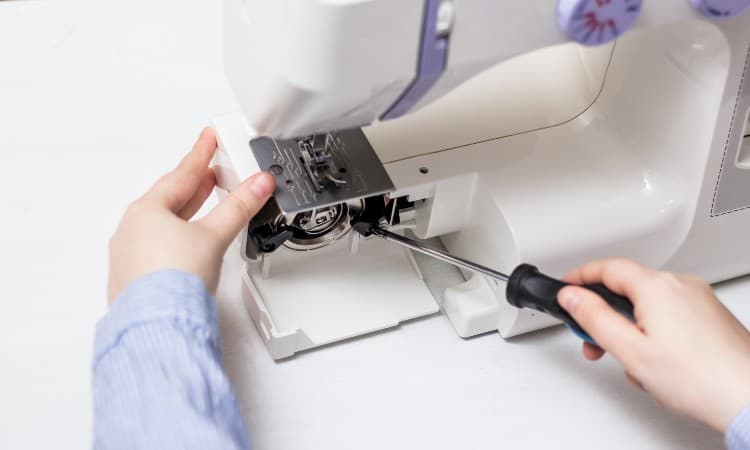
How to Repair Your Sewing Machine
Have you run into an unforeseen issue with your home sewing machine? If so, you’re probably looking into how to repair it. You’ve got two very basic options: find a professional technician, or do it yourself!
Repair Shops / Technicians
Experts recommend taking your machine in for a professional tune-up at least once every three years. If your machine refuses to turn on, you may need expert help. If it makes strange noises or frequently jams up while running, it needs immediate attention.
Often, even expert home sewers prefer to pay a technician to tune-up or overhaul their machines. This is because sewing machines can be quite complex, especially modern, computerized models. On top of that, every brand and model differs and each has its challenges!
Think of this as the difference between changing the oil in your car by yourself or taking your car to the mechanic for a once-over. You know the mechanic–an expert in the field–will find any issues and fix them correctly.
If you choose to take your machine in for repair, make sure you bring all the essential parts. You will need the power cord, foot peddle, and standard presser foot.
At Home
On the other hand, these days, you can learn how to fix, build, or modify pretty much any small appliance through the magic of the internet! Sewing machines are no exception. Here’s the thing: you absolutely can learn how to fix your machines, but that doesn’t mean it will be easy.
Learning anything well takes time. Learning how to take apart and put together a complex mechanical appliance takes time!
If you’re willing to put in that time and effort, though, you will gain the confidence of truly understanding your sewing machine. Knowing how to make your repairs will also allow you to save time and money and ultimately help you become a better sewer!
How to Repair Your Sewing Machine at Home
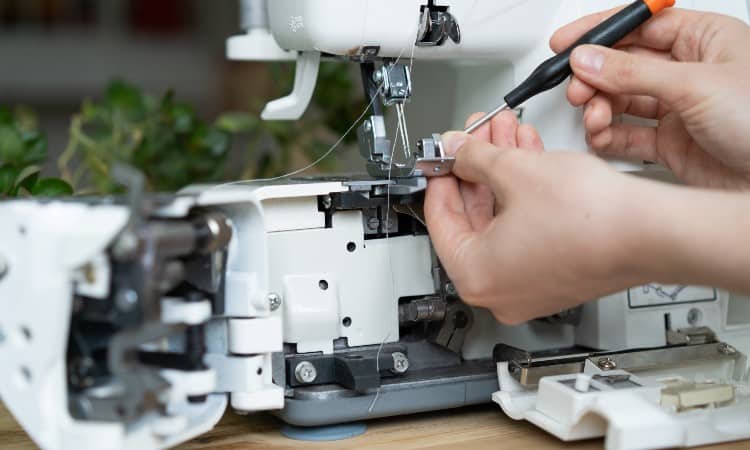
It’s a good idea to seek out some structured training if you want to make repairs confidently. However, you can also find books, videos, and free online resources to guide your at-home learning.
Few minor issues, like learning how to clean the machine, you can probably get away with following along with a Youtube video.
You will want to have a variety of simple tools on hand before you begin any DIY fixing. First, you will need a lint brush and sewing machine oil to clean your machine. You may also need a small flat-head screwdriver to fit the screws that hold your machine casing.
Even for simple issues, you should probably have a diagram of the relevant components on hand. You can refer to this as you work.
Last but not least, here are two pro tips for you! Make sure you unplug your sewing machine before beginning any task, even simple cleaning.
Secondly, take a picture before you take it apart! You may think you will remember how everything fits together, but why risk it?
For more detailed suggestions about learning resources, scroll down to the “sewing machine repair DIY” section later in this article.
Why Learn How To Fix Sewing Machines?
In general, people want to learn how to fix sewing machines for two reasons: to DIY issues in their machines or to find a job as a sewing machine repair technician.
You may want to learn how to repair a sewing machine to maintain your machine, so you can save money instead of paying a technician, or even so you can become a technician yourself!
If your goal is to learn how to make simple repairs to your machine, you can find lots of free resources to develop your skills at home. You will also pretty quickly discover that understanding how your machine works will make you better at sewing!
If you plan to become an expert, though, you’re going to need to take some additional steps. Some sewing machine technicians take a course that leads to certification. Others find a shop to apprentice at and learn in a hands-on manner.
How Much Does it Cost to Repair a Sewing Machine?
Sewing machine repair costs vary a lot based on the complexity of the issue, the type of sewing machine, and even the place where you live. Most technicians charge at least $100 just for a simple tune-up on an average domestic machine. If the high cost inspires you to learn a bit about taking care of your machine yourself, great!
Before you get too outraged about the typical fees for sewing machine repair, though, keep in mind that a $100 charge is pretty typical for a computer or phone repair, too.
Someone who has become an expert in a fairly rarified field can afford to charge for their services.
Fees go up for more complex machines like sergers and embroidery machines. Even a basic adjustment on an embroidery machine will probably cost upwards of $200.
Just like with a car repair, you also need to factor in the price of any replacement parts your machine might need as well.
Finally, where you live probably impacts the price range, too. Geographical locations where the cost of living is high tend to have higher fees for things like service technicians.
Your best first step in deciding whether or not to pay a sewing machine technician is to call a local shop and ask them how much they charge for a tune-up for your particular brand and model of machine.
Is it Worth it to Repair a Sewing Machine?
Usually, paying for a repair will cost a lot less than purchasing a new machine. In a perfect world, making sure your machine is regularly cleaned and maintained will prevent the need for big repairs that cost a lot.
Of course, if you can learn even the basics about how to keep your machine running on your own, you will extend its life considerably without paying expensive service charges to a professional!
Better yet, if you get certified and become a sewing machine technician yourself, and you can make money fixing sewing machines for other people!
Sewing Machine Repair Schools, Classes, Courses
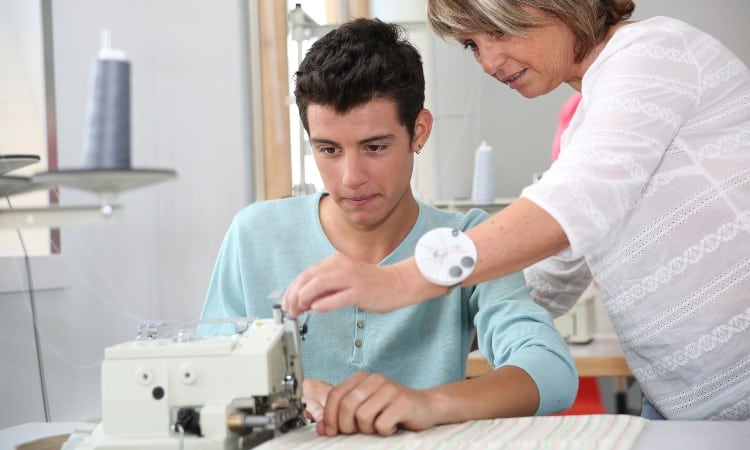
If you want a structured, thorough learning experience, you probably need to look into a paid training. Depending on how much you can afford to spend, you may prefer a one-hour workshop, a multi-week class at a nearby school, or an official certification course.
Schools
There are not a lot of schools out there that specifically focus on sewing machine repair. Singer has a couple, though. These schools have an excellent reputation and give you a solid education!
You can also check out The Sewing Machine Repair School, especially if you live near Texas!
These classes range in price from about $100 to $800 for some of the multi-day sessions.
Classes
Often community colleges will offer classes on hobby subjects like sewing machines. The cost of these classes varies from place to place, but you might find a class for as little as $100-$300.
Community colleges sometimes include these kinds of classes in the “life-long learning” “life enrichment” or “arts and crafts” sections of their course catalog. Of course, these courses change every semester, so keep an eye on that catalog!
You may not find a sewing machine repair course at every community college during every semester. However, here is the link to Baltimore County Community College in Maryland to give you an idea of the breadth of courses offered at any given time.
You could also try Googling “sewing machine repair classes near you” if a local sewing shop or community center is holding an event.
Training Courses
In terms of paid training options, a certified course is the most official way to go. For example, the Sewing Machine Institute offers regular training courses that cover all types of sewing machines and give you a thorough grounding in all major kinds of repairs. Sewing Machine Repair Courses does as well.
However, partly because these can be lengthy courses and partly because you receive official certification after completion, this is not a cheap option. These courses can cost upwards of $1000!
Workshops
Workshops are essentially really short classes, often only an hour long. Local sewing stores are probably the best place to look for these! If you drop by nearby quilting, crafting, or sewing store and ask the proprietor, they may be able to direct you to the best local resources.
Because they are short, workshops don’t usually cost as much as a full-fledged class. However, you won’t get official certification from these, either.
If you can’t travel to an in-person workshop right now, try a free Youtube series like this one produced by Man Sewing. You won’t get the hands-on experience of a live workshop, but you will get a visual guide on addressing common issues.
Paid Online Classes
You can also find online classes that usually have a lower entry fee. These are especially good if you seek to become an expert on a particular brand of sewing machines. For example, you can find a webinar about mending a Janome or Bernina machine pretty often, either through a local store or by following a sewing blogger.
Artizan Training offers paid online courses on a variety of domestic and industrial sewing machines.
Sewing Machine Repair offers a variety of classes and print resources and also some online videos.
Embroidery Machine Repair Training
Your best bet at learning how to repair these complicated machines is probably through an official course or in-person instruction.
Embroidery machines have many complex functions and capabilities. Most of them are computerized. These machines cost a lot, and getting them repaired can be pricey as well!
The Sewing Machine Institute does offer a paid, certified course on embroidery machine repair, currently available for $70. If you’re looking for a free resource to get you started, TexMac Direct offers video of their archived webinars on their website.
Sewing Machine Repair Shops Nearby
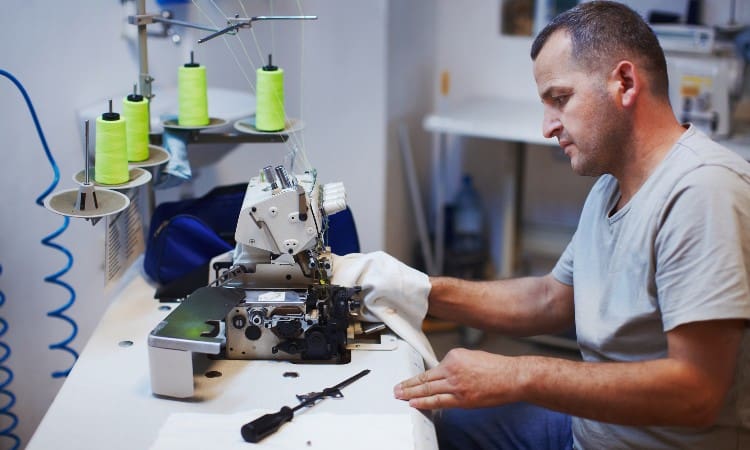
The easiest way to find a repair shop near you is to Google it! You can also drop in at your local Joann Fabrics and ask the staff if they know of a good shop.
Many small sewing, quilting, crafting, or upholstery shops will also have a technician on staff.
At this time, Joann Fabrics does not seem to offer a repair course, though they do provide classes to learn about the different brands of sewing machines at their Sewing Studios.
Become a Sewing Machine Technician: Does Certification Matter?
Gaining your certification can be a thorough and informative way to learn what you need to know before entering the field of sewing machine repair. Many technicians also get their start in this field through an apprentice-style learning system.
Some shops may require certification. Many do not and instead prefer to train employees themselves.
How hard is it to become a sewing machine repair professional? This probably depends on how much time and money you are willing to invest in the process. If you can afford a certification course that might cost upwards of $1,000, you will be well on your way toward applying to any shops near you.
Your other best option would be to visit those shops, meet the technician, and ask if you could work part-time at a low rate of [ay while you learn from them.
Sewing Machine Repair Job Opportunities
It’s difficult to say exactly how many job openings are available for potential sewing machine repair technicians for many reasons, one being that people often come to this field through apprenticeships instead of through job postings.
Sears and Joann Fabrics seem to farm out their repairs to local technicians, though, so there is a job market!
The general consensus on the pay rate is that people in this field typically make between $15-$25 per hour. This doesn’t sound like a lot, but you may find dabbling in this field a useful part-time job or side hustle.
Sewing Machine Repair DIY
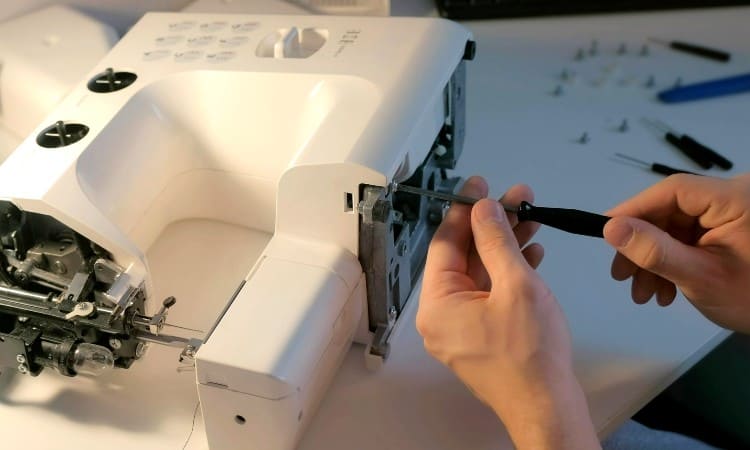
If you’re not looking for a job and want to keep your machine running, you can try the tips listed here or check out some free resources for even more information!
Common Sewing Machine Problems
Unless you have decided to take one of the intensive paid courses described earlier, you probably want to stick to the basics with your DIY fixes.
Deep Clean
It’s unlikely that the grime inside your machine prevents it from running. That said, learning how to perform a thorough cleaning yourself will save you the price of taking your machine in for a check-up!
Your manual should give you suggestions for what to clean and how to do it. To list a few key areas, you should remove the needle plate and presser foot, remove the bobbin and bobbin casing, and use a tiny brush or small vacuum attachment to get all the accumulated lint out of there.
You should also clean the thread path. Sometimes this means removing a side panel from your machine.
Don’t panic! All you need is a small screwdriver. Be sure to set the screws aside in a safe place so you can put everything back together when you’re done!
At the very least, you can run a stiff cotton thread through the path a few times to clear out the lint! Wiping down the outside of your machine after every use will help prevent this lint buildup.
Some machines also need a tiny amount of lubrication added after you clear away the lint. Check your manual on this one! If you do add lubricant, only actual sewing machine oil, not any other kind.
You should also regularly replace the needle as it can get dull or even bend quite easily over time.
Rethread
Every book, every blog, and every youtube video pretty much starts with this advice….if something has gone wrong, the first thing you should try is rethreading your machine! This means pulling the thread completely out of the thread path and rewinding it through the tension discs and back to the needle. It means taking the bobbin out and rethreading that, too.
Why does this help? Sewing machines use tension to keep both threads taunt as they sew. If a thread has slipped free of the discs that keep it tight, you will see a tangled thread, bunched-up fabric, or even a machine that refuses to sew because the thread is so tangled it is holding the needle immobile!
Turn It Off
Do any of you remember that British sitcom The IT Crowd? You know how when the IT department answered their phone, they always started a conversation with, “Did you try turning it off and back on again?”
It sounds a little silly, but sometimes what works for computers works for sewing machines, too! (Especially if you have a computerized machine). When you turn the machine back on, make sure that all the settings and switches are turned on correctly.
Check the Tension
Technically this is another setting, but not everyone feels confident messing with it! Some home sewers suggest that you take your machine to a professional for this service.
It would be a good idea to read your user manual and then test out the various tension settings on a piece of scrap fabric. Then, once you know how the settings work, you will feel more confident adjusting them in the future!
Complex Repairs
If you try all the simple fixes and cleaning techniques, and your machine still won’t work, you may need help. For example, if the drive belt inside the motor snaps or cracks, you probably want an expert to replace it.
Free Resources
Your sewing machine manual is an essential reference for any simple cleaning or adjustments. Honestly, you should flip through this little guy from front to back before you even think about sewing anything!
Everything you need to know about threading the machine, cleaning the machine, and adjusting settings can be found in the manual, often along with helpful diagrams.
Of course, the manual is intended to help home sewers accomplish basic repairs and maintenance. It will not describe in detail how to perform advanced tasks.
For more visual learners, Youtube provides wonderful guidance for pretty much any sewing machine repair you might want to try! The trick here is that you need to make sure the video is about the correct brand and model of the machine. If the video demonstrates how to thread a Singer and you have a Janome, it won’t help.
Pinterest and sewing bloggers also provide a wealth of free knowledge. If you visualize well, reading a written description of how to fix your machine may make the most sense to you.
Books
You can find plenty of books on types of sewing machines, how to use sewing machines, and even how to sell sewing machines. It’s a bit trickier to find a reliable book on fixing sewing machines, but they are out there!
Here are two sample reviews of sewing machine repair guides you can find on Amazon. If you are looking for free resources, you can always ask your local public library if they carry any sewing machine repair guides!
The Sewing Machine Master Guide: From Basic to Expert
 Written by sewing machine expert Clifford Blodgett, this comprehensive overview of many different makes and models will serve as a reference for understanding what your machine can do and also give you advice on how to maintain and fix it when something goes wrong. This guide clocks in at over 300 pages, which gives you an idea of just how in-depth and informative it is!
Written by sewing machine expert Clifford Blodgett, this comprehensive overview of many different makes and models will serve as a reference for understanding what your machine can do and also give you advice on how to maintain and fix it when something goes wrong. This guide clocks in at over 300 pages, which gives you an idea of just how in-depth and informative it is!
Because this book examines so many different models, it doesn’t dedicate quite as much space to repair advice. However, it will give you a good idea of what challenges and benefits you can expect from many different kinds of sewing machines.
This guide also discusses both domestic and industrial sewing machines. You don’t see self-help advice for heavy-duty machines as often, so if you plan to repair an upholstery machine, this is the book for you!
Sewing Machine Repair for the Home Sewer
 This affordable guide is a rare example of a DIY repair manual that addresses the issues and concerns of the home sewer! Written by technician Reuben Doyle, the guide takes the reader through informative scenarios featuring common sewing machine ailments. It then describes step-by-step how to fix these issues yourself.
This affordable guide is a rare example of a DIY repair manual that addresses the issues and concerns of the home sewer! Written by technician Reuben Doyle, the guide takes the reader through informative scenarios featuring common sewing machine ailments. It then describes step-by-step how to fix these issues yourself.
Some readers point out that this book is a general guide and does not describe the issues specific types and brands of machines may have. For example, this book doesn’t address how to repair vintage sewing machines.
However, this is a great book for readers who don’t want to get bogged down in a comprehensive manual. This brief 106-page book will give you a helpful start and the confidence to handle basic issues without panicking.
Conclusion
Do you feel ready to dive into the world of sewing machine repair? Hopefully, you feel confident about where you can go to get trained as a sewing machine technician, what you can do to maintain your home sewing machine yourself, and even how much it typically costs to pay someone else to repair your machine.
Are you having issues with your sewing machine? Do you think you will attempt to fix it yourself? Leave a comment below to let us know!